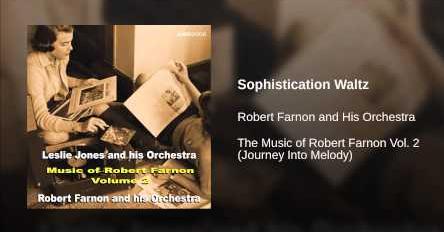SOME
THOUGHTS, IN-DEPTH ANALYSIS AND A
REASSESSMENT OF THE MUSIC OF THE
GENTLE GIANT OF THE
MINIATURE.....
Robert
Farnon
By Robert
Walton
SOPHISTICATION
WALTZ

Robert Farnon's
miniatures tend to fall into one
of two categories. Either the
rousing attention seekers or the
modest "no fuss" ones
which sort of seep into the
senses. Ironically the latter can
often have more impact. Why
should this be? Perhaps it could
be compared to a softly spoken
person one is drawn to in a
crowd, as opposed to the
loud-mouthed show-off type. Of
course it's the content that is
most important, but sometimes (as
comedian Frank Carson says),
"It's the way you tell
'em!"
The effortless Sophistication
Waltz sounds as if it wrote
itself, unlike some Farnon
numbers that give the impression
of having being endlessly refined
and sculptured down to the last
detail, until complete
satisfaction has been achieved.
(Beethoven was also a
perfectionist, never accepting
the first draft). But
occasionally along comes an idea
so simple and original it would
be foolish to change a thing.
Just go with the flow as they
say! All Farnon had to do with Sophistication
Waltz was enrich it with his
own brand of enchanting
orchestration and harmony and ...
Bob's your Uncle! Not a problem.
For him it was like falling off a
log. Probably something he
casually tossed off, but you'd
never know it from the meticulous
craftsmanship. So let's see if we
can uncover some of the secrets
of Farnon's style, and at the
same time share the pleasure of
one of his most lilting waltzes.
From the very
start an air of mystery pervades
the piece, as we go into an eight
bar introduction which you'd
swear was taking us straight to
the main melody. But no! Farnon
completely fools us with four
extra warm up bars, in which the
first note of the actual tune is
held throughout, and ending with
an ascending bell-like effect.
Once the tune is up and running
though we can sit back and enjoy
a magical melody by this modern
day "Johann Strauss
2nd." Being quite a fastish
waltz it doesn't hang about. The
stealthy strain ascends almost
step by step in much the same way
as That's Entertainment,
and more than any other piece I
know, has such built-in markings
relating to interpretation, that
the dumbest musician would give a
perfectly adequate performance.
Then shortly
Farnon casually slips into A
flat, but only for a moment, and
we're soon back on track after a
bluesy/Hawaiian type cadence
returns us to the written key of
C. And then we find ourselves
briefly in E flat. Farnon makes
these unrelated keys seem quite
natural in the general scheme of
things. The first eight bars of
the actual tune of Sophistication
Waltz could be the work of
any professional light orchestral
composer, but that unexpected
move into A flat, places Farnon
in a class of his own. The melody
has been lifted out of the
commonplace into the rare. This
is true of so much of his music.
The waltz as we knew it would
never be the same again. Suddenly
it soars! In one defining moment
the dance has been re-invented.
But it’s only when we reach
the first climax, we become aware
of such a beautifully shaped
composition.
On entering an A
flat bridge we realise the
earlier brief encounter with that
key was but a taste of things to
come. A complete transformation
has taken place. This is now a
full-blown waltz. And borrowing
from the main theme, Farnon uses
that bluesy cadence four times.
If you were expecting the final
chorus to revert back to its
introspective opening you’d
be mistaken. Clearly the middle
section mood was contagious
because those ravishing Farnon
strings now triumphant take over.
The piece ends, as it began, in a
quiet mysterious mood.
Weber might have
been the first to give the waltz
a new look with his Invitation
to the Dance (1819), but
Farnon is the 20th century
equivalent. In fact he's more.
It's one thing arranging
something imaginatively, but
quite another to break new
compositional ground as well - to
go where no one else has been.
Even if Farnon had only written
for the piano, his originality
would have still shone through. Sophistication
Waltz with all its harmonic
subtleties and orchestral
ingenuity could still be
appreciated by the man in the
street, even if he didn't realise
he was listening to something
fresh and exciting. A good deal
of that is achieved by Farnon's
inner parts. With a simple tune
like this, most arrangers would
have settled for just one chord
per bar, but Farnon provides
internal momentum with a variety
of harmonies and passing
dissonances which reveal
unsuspected beauty. They might be
gone in a flash but without them
the result would be extremely
dull. Students of harmony should
study the discipline of his
writing. It may be unconventional
but it all fits together like
clockwork. From the intoxicating
melodies and joyful rhythms of
Vienna, to the intricate sounds
of our own times, Robert Farnon
climbed one small step for a man,
but one giant leap for music!
|